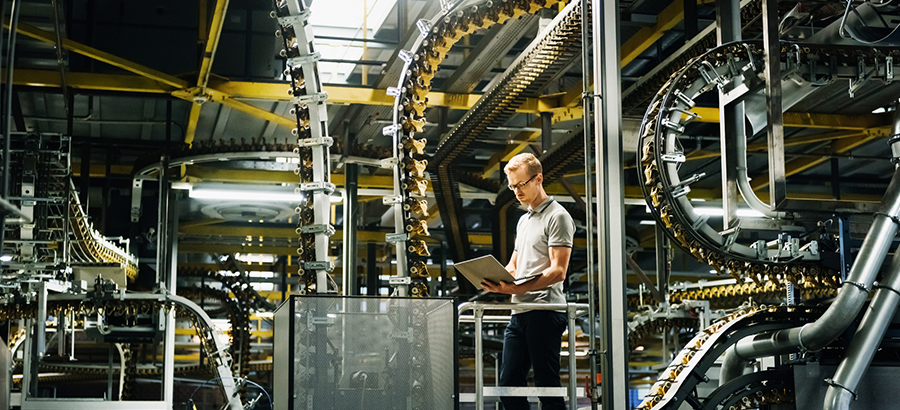In today’s manufacturing environment, many businesses have implemented the latest systems or adapted to concepts and technologies they only thought they would be using in the future. Often, digital disruption and digital innovation are the driving force behind these changes. For example:
- The Internet of Things (Iot) which has simplified the collection of data across the world.
- Running Equipment with an app that controls the critical operational parameters, and no longer requires
- The concept of Products-as-a-Service means that customers won’t pay for a product outright but will pay for uptime availability and usage.
- The drive to sustainability requires machines to contain parts made recycled content.
While these may be marked as “optional” at the moment, they may not be “optional” in the near future. If you consider how quickly technology has advanced in the last few years, IM & E companies need to hastily address their existing challenges and prepare for the new ones ahead.
Challenges
The Fictiv 2021 State of Manufacturing report showed that the pandemic has brought several operational challenges to the fore, and has also introduced a number of new challenges.
Product design
Industrial Machinery and Equipment manufacturers regularly deal with complex specifications as well as production problems. Whether for initial orders for machines, or for changes to existing machines, translating these requirements into engineering requirements can be a complicated and very difficult. There needs to be a structured change process supported by appropriate software to convert specifications and integrate them with existing designs. These also have to consider production plans and inventory requirements. Specialist product design also relies on details from suppliers, and without timely feedback, it is difficult to make optimal design decisions.
Production planning and management
Keeping track of jobs and planning production for new orders is a challenge for manufacturing teams. Visualization of the production process helps evaluate the actual progress of a job, giving an indication of where there could be potential delays. This is required to ensure that manufacturing is on time and deliveries are on schedule. Key manufacturing and supply chain management tasks, normally with a huge overlap in responsibility and yet the ability to solve these manufacturing challenges when they are working together.
In the planning of jobs, one of the main difficulties is critical resource management. To resolve this, manufacturers need to link resources (people and materials) to jobs so that they can timeously address changes like escalations, interruptions, and absences.
Quotation management
This is the biggest challenge that the IM&E manufacturers face as most of their work is won by quotation. While manufacturers want to reduce the cost of generating quotations and improve conversion rates, a substantial amount of time is spent calculating costs to offer accurate quotations. Timeous responses to requests for quotations will determine the success rate yet inaccurate quotations will lose the manufacturer money due to the extremely low margins. A real dilemma!
Without access to accurate information, correct costs and precise production processes, the quote may not be accepted resulting in lost sales. Consequently, Sales personnel need access to all process details, ensuring that they can get a competitive quote to their customers.
Inventory management and forecasting
Most manufacturing companies have complex supply chains and often have limited insight into the operations that occur outside of their own factories. Greater visibility of the supply chain and its nuances would reduce uncertainties and assist with better planning and inventory management.
There is also significant amount of work required to accurately manage the considerable amount of inventory and parts that typical IM & E companies must hold. Accurate and timeous dispatching of this to the shop floor when it is required is critical to ensure that resource consumption is balanced, and delivery schedules are met.
Accurate Demand forecasting is an important requirement for accurate, timely and effective production. It also required for optimal inventory levels to ensure that the promised delivery dates to customers are met. The accuracy of forecasts depends on the accuracy of this data. Usually, this data is based on historical trends and seasonal patterns, and collecting this data requires collaboration between all stakeholders and across the whole supply chain, including customers.
Quality control and traceability
Increasingly, manufacturers are being held responsible for the quality of products they deliver. This is to ensure that at all times products exceed minimum standards. If there are problems, the ability to trace the faulty items or parts from procurement, right through production to delivery is now an expectation that customers have for all suppliers.
Customer centricity
Manufacturers can also reap significant benefits by understanding the near-term problems of the customers. This will improve planning and will assist with responding to regulatory changes. Ultimately, the partnership should lead to improved profitability for both companies.
By monitoring customer information, companies can segment customers based on a range of details which should help develop a better understanding of customer needs and the offerings that might appeal to them.
Product life cycle
In addition to thinking about their physical products, manufacturers should consider what developments and services the products may need over their lifetimes. This requires a thorough planning of the product as well as looking at the specialist tools that will be required to support them. Apps and other digital services may need to be developed to enable this. In some cases, products may have both physical and digital product launches which will require separate planning and launching.
Sustainability
Manufacturers need to be aware that their consumers are increasingly looking at environmental impacts of the products. Sustainable manufacturing is the production of goods and services using processes that reduce negative impacts on the environment while trying to conserve energy and natural resources. In many countries, there is a growing list of environmental regulations that need to be considered for future products.
How ERP helps IM & E
One area companies in the IM & E sector should look is to the latest advancements in technology to help address these challenges.
- An integrated system: In the area of production design, planning and manufacture, companies need an integrated system so that the different manufacturing functions don’t operate in isolation. New specifications and change orders should not only change design plans but also be communicated to the resource planning (e.g. Bill of Materials and Master Production Schedule) at the same time. Online collaboration with suppliers is critical to ensure that design specifications are accurately communicated, and changeover plans executed.
- IoT devices on the shop floor: The traditional shop floor is changing. Some manufacturers have realized that these new digital technologies can significantly reduce costs, improve productivity, and reduce errors. Having the ability to process the data produced from inter-connected systems (including IoT devices on the factory floor) allows businesses focus on optimizing production operations and improve the end-to-end manufacturing process.
- Sales order processes: In a similar way, sharing sales order processes with the rest of the organization, can provide the latest information that is needed for accurate and speedy quotations. While capable-to-promise may not be so easy in the complex IM & E environment, sales personnel can view the current statuses of production orders and inventory availability, enabling them to give better customer service.
- A supply chain portal: An ERP system integrates information from across the business, providing better information to manage the availability of parts and items in the warehouse. Building an agile supply chain requires a strong partner ecosystem and using an ERP solution with an online portal for suppliers, allows collaboration on pricing, stock availability and planned delivery which can improve inventory levels and ultimately customer service.
- Traceability: An ERP solution that has a full traceability system provides the ability to trace, identify, isolate, report, quarantine, and place affected products on hold quickly and with minimum disruption. It can give visibility throughout the value chain to ensure quality and compliance with regulatory requirements. In today’s manufacturing environment, the customer is expecting management of the asset by the supplier as well as a warranty.
In the new world of manufacturing where the product is part of a package that contains services as well, the ability to connect to digital services will become paramount. While there are applications that support this, integrating and consolidating their information into the organization’s ERP is improving. An ERP solution with the ability to connect to a broad range of systems means that those services provided to customers can be managed from a central control position.
To achieve sustainable manufacturing, businesses must be able to monitor consumption of resources in the production process to see what is being wasted, and to identify how to best recycle that material. An ERP system can assist to monitor consumption of materials by process and help to address sustainability in a coordinated, integrated, and formal manner.
The new normal for manufacturers
The Fictiv 2021 State of Manufacturing report has shown that many companies are in the process of becoming more digitally proficient and organized. For example:
– 91% have increased digital transformation investments in the past year;
– 95% believe that digital transformation is essential for future success;
– 54% aim to increase the speed of product innovation by adopting digital technologies;
– 40% state they are prioritizing investments in sustainable manufacturing processes.
That’s a substantial segment of the businesses, and manufacturers should therefore be asking themselves these questions:
- Are we going to be in the minority who resists change because it seems risky?
- Are the old business models are changing? Are our business models changing? If so, which ones, and how are they changing?
- Which technologies should be prioritized for adoption to support the new business models?







